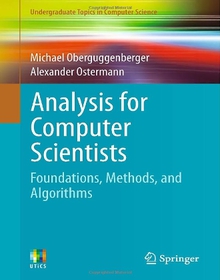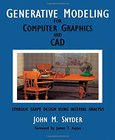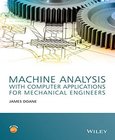Analysis for Computer Scientists
Foundations, Methods, and Algorithms

Book Details:
| Publisher: | Springer |
| Series: | Springer , Foundations |
| Author: | Michael Oberguggenberger |
| Edition: | 1 |
| ISBN-10: | 0857294458 |
| ISBN-13: | 9780857294456 |
| Pages: | 337 |
| Published: | Apr 06 2011 |
| Posted: | Nov 19 2014 |
| Language: | English |
| Book format: | |
| Book size: | 7.45 MB |
Book Description:
This textbook presents an algorithmic approach to mathematical analysis, with a focus on modelling and on the applications of analysis. Fully integrating mathematical software into the text as an important component of analysis, the book makes thorough use of examples and explanations using MATLAB, Maple, and Java applets. Mathematical theory is described alongside the basic concepts and methods of numerical analysis, supported by computer experiments and programming exercises, and an extensive use of figure illustrations. Features: thoroughly describes the essential concepts of analysis; provides summaries and exercises in each chapter, as well as computer experiments; discusses important applications and advanced topics; presents tools from vector and matrix algebra in the appendices, together with further information on continuity; includes definitions, propositions and examples throughout the text; supplementary software can be downloaded from the books webpage.
Download Link:
Related Books:
Vector Analysis for Computer Graphics
This book is a complete introduction to vector analysis, especially within the context of computer graphics. The author shows why vectors are useful and how it is possible to develop analytical skills in manipulating vector algebra. Even though vector analysis is a relatively recent development in the history of mathematics, it has become a powerful and central tool in describing and solving a wide range of geometric problems. The book is divided into eleven chapters covering the mathematical foundations of vector algebra and its application to, among others, lines, planes, intersections, rotating vectors, and vector differentiation....
Generative Modeling for Computer Graphics and CAD
Symbolic Shape Design Using Interval Analysis
Machine Analysis with Computer Applications for Mechanical Engineers
The aim of this book is to motivate students into learning Machine Analysis by reinforcing theory and applications throughout the text. The author uses an enthusiastic handson approach by including photos of actual mechanisms in place of abstract line illustrations, and directs students towards developing their own software for mechanism analysis using Excel Matlab. An accompanying website includes a detailed list of tips for learning machine analysis, including tips on working homework problems, note taking, preparing for tests, computer programming and other topics to aid in student success. Study guides for each chapter that focus on teaching the thought process needed to solve problems by presenting practice problems are included, as are compute...
2007 - 2021 © eBooks-IT.org



